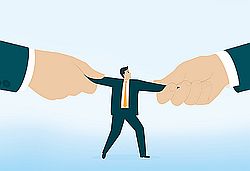| Excerpt from www.NDMA.COM, © 2025 N. Dean Meyer and Associates Inc.
Use Case: Digital Business
what is it, and what's the role of a Chief Digital Officer?
by N. Dean Meyer
[excerpt from the book, How Organizations Should Work]
The concept of "digital business" is not new, although the term became popular more recently. With recognition of importance of digital business, many companies have hired a Chief Digital Officer. That role often creates controversy, and friction with both IT and Marketing that gets in the way of its success. This article defines the concept, and analyzes the appropriate role of a Chief Digital Officer (CDO).
What is "Digital Business"?"Digital business" refers to a type of benefits to be derived from technology. There are multiple ways that information technologies (IT) can contribute to enterprise strategies. The figure below shows a staircase of value to be gained from technology.
Levels 1 through 3 are just traditional operational benefits and efficiencies. Levels 4 through 6 are value-added benefits -- the strategic value of technologies. Originally, digital business meant just Level 5 -- using technologies to enhance relationships with external customers. Since then, some have come to include Level 6, technology embedded in a company's products and services, including the Internet-of-Things (IoT). Some even use the term to describe all the strategic benefits of technology -- Levels 4, 5, and 6. As it turns out, what it takes to deliver Level 5 (customer intimacy) is pretty much the same as what it takes to deliver Levels 4 and 6. So, when we talk about gearing up for digital business, we may as well be talking about how to deliver all those top-three levels of strategic value.
Digital Business is Not a TechnologyIn its original conception, digital business was thought to mean smart-phone applications for customers, social media (both involvement and advertising), technology-enabled marketing programs such as customer-tailored coupons and loyalty rewards, a company's externally facing web site, and perhaps data-analytics tools to understand customers and markets. But over time, people have come to understand that customer relationships can be enhanced by many things. Digital business is really about the entire customer experience. That includes the way customers interact with your products, your staff, your marketing, your support -- everything. When you look at it that way, digital business isn't a subset of information technologies. It utilizes the entire range of tools, in virtually every business function, to improve customers' experiences. Even "back-office" functions impact customers' experience, and hence have digital-business opportunities. Consider, for example, Finance's role in customers' concerns about their invoices and payments. Digital business opportunities are everywhere, and they may employ the entire IT toolkit.
A Continual Process (Not a Project)Here's another key observation: Digital business is not a one-time project, or even a multi-project program. It's a continual stream of initiatives that deliver on that promise of digital business, an ongoing process of uncovering and addressing opportunities for the strategic use of technologies in every aspect of a business. So, it's not a matter of one bright leader or small group somewhere in a company who comes up with all the digital-business ideas. It has to be built into the way the whole organization operates. Therefore, the salient question is, what continual processes do you need to get an entire organization focused on digital-business opportunities?
Requisite ComponentsThere are many business and IT functions that might be involved in a digital-business initiative. To start, there are people who are focused on creating value for customers -- externally facing product managers. They're continually looking for ways to grow their market share, insulate themselves against competitors, and improve margins. The original view of digital business was applying technologies directly to their customer-intimacy challenges. Externally facing product managers "buy" help from many different internal services -- Sales, Marketing, Engineering, and so on. And all those support functions are hungry for help from technology, too. Of course, the better they perform, the better product managers do at pleasing customers. IT is eager to help all of them. To find digital-business opportunities, IT needs people who specialize in understanding the linkage between technologies and their internal customers' businesses. That's the role of Sales in an IT business within a business (often labeled "Business Relationship Managers"). This first requirement is a matter of structure. Those Business Relationship Managers help customers conceive technology-enabled business strategies (a capability, or method). That alone is a powerful contribution, even before IT delivers any technologies. Then, Business Relationship Managers need a method of strategic opportunity discovery to identify specific digital-business opportunities for specific business functions (within those broader enterprise strategies). Of course, those projects need funding. That's a matter of getting your resource-governance processes (internal economy) right. You'll need investment-based budgeting to ensure funding for digital-business initiatives. And the budget has to provide for continual IT product development, because you'll need diverse and up-to-date IT technologies and services to tap emerging opportunities and stay a step ahead of your competitors. Also, you'll need a demand-management process that puts strategic opportunities at the top of the priority stack, ahead of more mundane projects and services that could easily consume all your IT resources. And to lubricate that process, you'll need a value-added benefits-estimation method to justify those strategic investments. That's something Business Relationship Managers can be trained to facilitate. And finally, you'll need to adjust your metrics to encourage judicious high-risk, high-payoff investments. In summary, here's how the organizational systems need to be aligned for a sustainable digital-business strategy:
Dangerous Definitions of a Chief Digital OfficerAmidst all that, what's the role of a Chief Digital Officer? The CDO job has been defined by different people in many different ways, some of which cause internal stress and are less effective. IT function: Some companies set up a whole separate IT group, alongside the CIO. This generates constant tension, primarily due to all the overlaps as those CDOs build their empire in their desire to be independent of the CIO. If a CDO replicates some IT functions, then it becomes another decentralized group competing with enterprise IT. There are many systemic reasons why decentralization is costly and less effective. First among them, a small group of IT generalists cannot perform as well as a larger enterprise IT department that has a higher degree of specialization. To make matters worse, decentralized IT groups often see their job as competing with enterprise IT, and "defending" their clients' interests against enterprise IT. The resulting tensions inhibit collaboration, perhaps denying digital-business opportunities the wealth of talent throughout enterprise IT.
Meanwhile, digital business needs access to all IT's products and services, as required by each specific opportunity. It can't possibly replicate all the IT engineering and service domains.
Furthermore, CDOs would find themselves managing engineering and service-provider functions. This diffuses the expertise of a CDO. They become IT generalists rather then specialists in the concepts of a digital business.
Marketing function: Some companies position the CDO as doing a piece of Marketing's mission. If a CDO claims control of all the strategic, visible, leading-edge aspects of Marketing, then the rest of Marketing becomes disempowered and disenchanted. Tension between the two competing Marketing groups is inevitable.
The confusion this competition creates impacts external customers as well. With no single group that coordinates marketing strategies and manages the communications channels, the company's messaging to the external world becomes dis-integrated and less effective.
Additionally, it's expensive to replicate marketing competencies (decentralization, again). The headcount would be better spent increasing the depth of existing Marketing groups.
Digital business is not even a function within an existing Marketing department. Technology can enhance every Marketing function; and every Marketing function should be engaged in contributing to a digital business.
Viewing the CDO as a Marketing function is a narrow definition of digital business. Marketing helps product managers to communicate their messages. They're one customer of the digital-business concept, eager for technologies that help them communicate and engage customers better. But there's a lot more to digital business than that.
Technology within Marketing: Some believe that a CDO is an IT group reporting to Marketing. This embodies the worst of both of the above -- viewing it as an IT function, and viewing it as a Marketing function!
It decentralizes IT, with all the costs that incurs. And it separates the concept of digital business from all the other Marketing functions, when in fact thay all should be actively pursuing digital-business opportunities.
Business unit: Certainly, digital business not a new business unit. It's a strategy for every business unit.
Sponsor: CDO is not a policy job maker, or a "sponsor" that exercises authority over others without accountability for their results, a violation of the Golden Rule. Sponsoring unfunded initiatives, issuing mandates, or making marketing or technology decisions for others all are misdeeds that fall in this category. Ultimately, this induces internal politics in a wide variety of insidious ways. And it's not productive.
Conversely, the CDO's role is sometimes given accountabilities that far exceed its authorities, ensuring its failure. It may generate many good ideas. But without the resources and authority to implement them, it won't get much done.
Even if it's given funding, the CDO cannot be a customer to IT for digital-business solutions. If a CDO sponsors a specific project, someone in a business unit somewhere (the one who should have sponsored it and has to use the resulting solution) would be disempowered -- forced to take on technologies decided by someone else (the CDO) and yet still accountable for their business results. That risks a lack of acceptance ("not invented here") and weak commitment to successful execution.
The CDO is not a decentralized IT group, nor a customer to IT. But it is IT related.
Therefore, CDO must be a sub-function within the broad domain of IT. It is a distinct expertise. But the nature of that specialty still falls within the domain of IT. Its job is to help the business discover opportunities and facilitate the application of IT to business strategies, an IT responsibility that's far from new.
If you're concerned about such a reporting relationship, examine those concerns and fix the root cause.
For example, if enterprise IT is not innovative, find out why. Is it a lack of funding or effective demand management? Is it an organizational structure that defines jobs around tasks, roles, and processes rather than lines of business? Is it a lack of entrepreneurship in the organization's culture? Or is it just poor leadership?
If you don't address the root causes of your concerns about enterprise IT, and you expect a CDO to make up for IT's deficiencies, it's unlikely the CDO will succeed. And it's unlikely the IT function will succeed at delivering relevant value to any business strategies, not just digital business.
The right answer is to make sure IT is a high-performing business within a business -- a Market Organization.
Once you address the root causes of your concerns, then enterprise IT will be the ideal home for a CDO -- rallying all IT's functions around a vision of technology-enabled customer intimacy for clients throughout an enterprise, and "selling the whole store" in a purely business-driven fashion.
|





